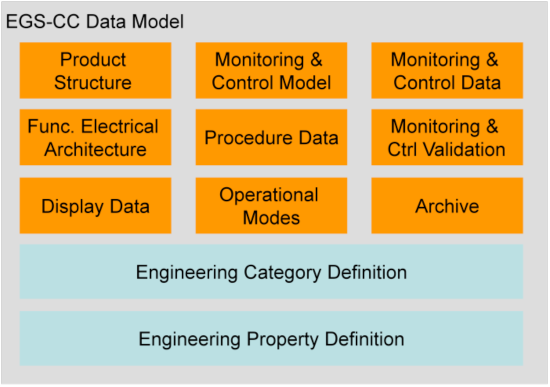The EGS-CC architecture is logically structured in separate layers, isolating different responsibilities and defining clear interfaces between them.
EGS-CC follows service oriented architecture principles.
EGS-CC is divided into three architectural layers, the Kernel, the Reference Implementations, and the Reference Test Facilities.

The Kernel contains the core functionality to be reused in all EGS-CC based systems. This consists of the M&C kernel, with generic monitoring and control functionality, archiving, and automation; and a set of application support components with functionality used both within and outside the Kernel. The Kernel is expected to be configured but not modified for use in any EGS-CC system.
The Reference Implementations consist of sets of components which can form complete EGSE/MCS systems in combination with the Kernel. Reference implementations can be extended or replaced in the different missions or projects implementing EGS-CC based systems. The reference implementations include all user interfaces, and adapters and interfaces for particular M&C standards such as the ECSS PUS, CCSDS packet and space data link standards, and ground equipment M&C standards.
The Reference Test Facilities contain the external elements required for a full validation of the kernel and the reference implementations in isolation. The principle elements are emulation of external interfaces and systems; the Reference Test Facilities also include capabilities for configuring, executing, and evaluating tests.
In order to fulfil its objectives, the EGS-CC design follows both a Component Based Architecture (CBA) and Service Orientated Architecture (SOA). This is supported by underlying middleware platforms which comprise:
The component framework supports the development and execution of EGS-CC components, the building blocks for a complete EGS-CC based system, while the service integration platform supports the integration of EGS-CC components, component composites and external systems to form a complete EGS-CC based system. The service integration platform is able to integrate heterogeneous systems communicating via different protocols, while the component framework offers a harmonised and optimised approach to component implementation based on a specific component model.
The EGS-CC includes a Conceptual Data Model (CDM) which defines the data needed to operate an EGS-CC based system. This is required to improve the efficient hand-over of data (and in that engineering knowledge) on the space system throughout the project phases of engineering, development, verification and operation of a space system. The following figure illustrates this concept, showing that conceptual data model is a key enabler for the exchange of data between systems, in this case between an EGS-CC based checkout system used for spacecraft AIT and the mission control system used for spacecraft operations.

The CDM identifies uniquely all data items in use along the process such that the interface between different EGS-CC based systems can be specified. The actual technology for the data exchange (e.g. XML) is not reflected in the CDM, but is such that the target representation can be generated. The CDM is therefore robust against future technology changes. The figure below shows the top level decomposition of the CDM and covers the data which eases the collaboration between the different parties involved in the space system engineering, development, AIT, verification and operation process.
